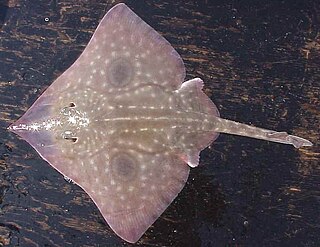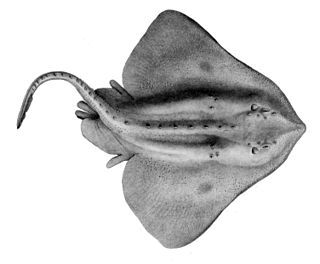
Raja, also known as raia, is a genus of skates in the family Rajidae containing 16 species. Formerly a wastebasket genus, many species historically placed here have been moved to other genera in the family, such as Amblyraja, Beringraja, Dipturus, Leucoraja and Rostroraja. Raja are flat-bodied, cartilaginous fish with a rhombic shapes due to their large pectoral fins extending from or nearly from the snouts to the bases of their tails. Their sharp snouts are produced by a cranial projection of rostral cartilage. The mouth and gills are located on underside of the body. They may be either solid-coloured or patterned, and most skates have spiny or thorn-like structures on the upper surface, and some species contain weak electrical organs within their tails. Mating typically occurs in the spring and the female lays numerous eggs per clutch which are encapsulated in leathery cases, commonly known as "mermaid’s purses". Species vary in size, ranging from about 40 to 140 cm (1.3–4.6 ft) in length. These bottom-dwellers are active during both day and night, and typically feed on molluscs, crustaceans and fish. Raja skates are found in the East Atlantic, including the Mediterranean, and western Indian Ocean, ranging from relatively shallow water to a depth of 800 m (2,600 ft). Skates and related species have fossil records dating from the Upper Cretaceous period, thus this well-adapted species is quite ancient.

The barndoor skate is a species of marine cartilaginous fish in the skate family Rajidae of the order Rajiformes. It is native to the northwestern Atlantic Ocean, and is found from the Grand Banks of Newfoundland and the southern side of the Gulf of St. Lawrence south to North Carolina. The fish is one of the largest skates found in the North Atlantic Ocean, reaching lengths up to 1.5 m (5 ft). It is carnivorous, feeding on invertebrates and other fish found near the sea floor.
The thickbody skate is a species of fish in the family Rajidae found off the coasts of Argentina, Chile, and Uruguay. Its natural habitat is open seas.

Amblyraja is a genus of skates that primarily are found in the Atlantic, but species also occur in the East and North Pacific, the Arabian Sea, the sub-Antarctic, and off Southern Australia and New Zealand.
The blackspot skate is a species of fish in the family Rajidae. It is found off the south-eastern coast of Africa from Durban, South Africa to central Mozambique. Its natural habitat is open seas. It has a triangular snout, tail stout that is moderately smaller than its body, and small thorns on the nape and back. On the upper side of the fish it is medium grey or a brownish color with black spots and the underside has noticeably black spores.

The big skate is the largest species of skate in the waters off North America. They are found along the Pacific Coast from Alaska to Baja California, typically from the intertidal zone to a depth of 120 m (390 ft), and feed on benthic invertebrates and small fishes. They are unusual among skates in that their egg cases may contain up to seven eggs each. This species is one of the most commercially important skates off California and is sold for food.

The broad skate is a poorly known species of skate in the family Rajidae. It occurs at depths of 846 to 2,324 metres, and has been observed via remotely operated underwater vehicle by the Monterey Bay Aquarium Research Institute as deep as 3,167 metres (10,390 ft), making it one of the deepest-occurring skates known. It is sporadically distributed in the Pacific Ocean, from the Gulf of Panama to British Columbia and the Bering Sea, to the Tohoku Slope off northern Honshu and the Okhotsk Slope off Hokkaido. The species name, badia, comes from the Latin batius meaning "brown", referring to its color.

The thorny skate is a species of fish in the family Rajidae. This bottom-living skate lives in the North and south-eastern Atlantic Ocean in depths ranging from 20 to 1,000 m (66–3,281 ft) and water temperatures from −1 to 14 °C (30–57 °F).
The bigmouth skate is a species of fish in the family Rajidae. It lives near the bottom in deep waters in Southeast Atlantic in depths below 1000 m. Its maximum size is 77 cm. It has a hard, roughly triangular snout and smooth body with star-based thorns around its eyes, tail, and elsewhere. Its top side is dark gray and underside has white spots. As the name suggests, it has a large mouth.
The Antarctic starry skate is a species of fish in the family Rajidae. It lives near the seabed in depths ranging from 20 to 350 m in the south-eastern Pacific near Chile and South Georgia Island. Its maximum length is 1 m. It produces oblong egg capsules that have four sharp thorns in each corner and measure 116.5 mm long and 80.0 mm wide

The Arctic skate is a species of fish in the family Rajidae. It lives near the seabed between 140 and 2,500 m deep in the Arctic Ocean and waters around Canada and northern and north-western Europe, in the northern Pacific Ocean, and in waters surrounding Antarctica and New Zealand.
The southern thorny skate is a species of fish in the family Rajidae. It lives off the coast of Argentina and Uruguay, and around the Falkland Islands in depths ranging from 51 to 642 m. Its maximum size is 69 cm. It lays oblong egg capsules with horn-like projections at the corners which are laid in sandy or muddy flats. The eggs measure 86.4 mm in length and 56.2 mm in width.
Jensen's skate, also known as the shortail skate, is a poorly known species of fish discovered in 2004 during a study of bottom ichthyofauna aboard the Norwegian RV G.O. Sars, where four species were identified, including A. jensieni.

The graytail skate, or gray tail skate, is a large species of skate in the family Arhynchobatidae, native to the south-western Atlantic Ocean and south-eastern Pacific Ocean. It is listed as endangered by the IUCN. It was caught as part of a commercial fishery around the Falkland Islands and is a bycatch in several other fisheries.
The Norwegian skate, or black skate, is a species of skate found at depths of 200 m (660 ft) to over 1,000 m (3,300 ft) in the East Atlantic region. Initially its range was believed to be restricted to the Norwegian Sea and North Sea to the Bay of Biscay. It is occasionally encountered off the western coast of Ireland, and historically has been found near Rockall and in the Norwegian Deep, though recent surveys have not identified the species there. The species has frequently been confused with other skates, and since the late 1980s it has been confirmed to occur more widely, ranging from Iceland to Morocco, as well as off South Africa and in the Mediterranean Sea.
Eudactylina corrugata is a species of parasitic copepod found on the little skate and the thorny skate that is only known from St. Andrews, New Brunswick and Woods Hole, Massachusetts.
Amblyraja reversa, commonly known as the reversed skate, is a deepwater skate known from a single specimen. Based on the single specimen, its range is predicted to include at least the Western Indian Ocean, specifically the Baluchistan coast in the Arabian Sea.
Dipturus teevani, commonly known as the prickly brown ray or Caribbean skate, is a species of cartilaginous fish in the family Rajidae. The prickly brown ray is medium in size compared to other skates, and is known from a patchy, deep-water distribution in the western Atlantic Ocean.

Fenestraja plutonia is a species of cartilaginous fish in the family Gurgesiellidae. It is commonly known as the underworld windowskate or Pluto pygmy skate. The underworld windowskate is known from patches of continental slope in the western Atlantic Ocean between the coasts of the southern United States and Suriname.

The grey skate is a species of fish in the family Rajidae. It was described in 2008 by Australian ichthyologist Peter R. Last.









